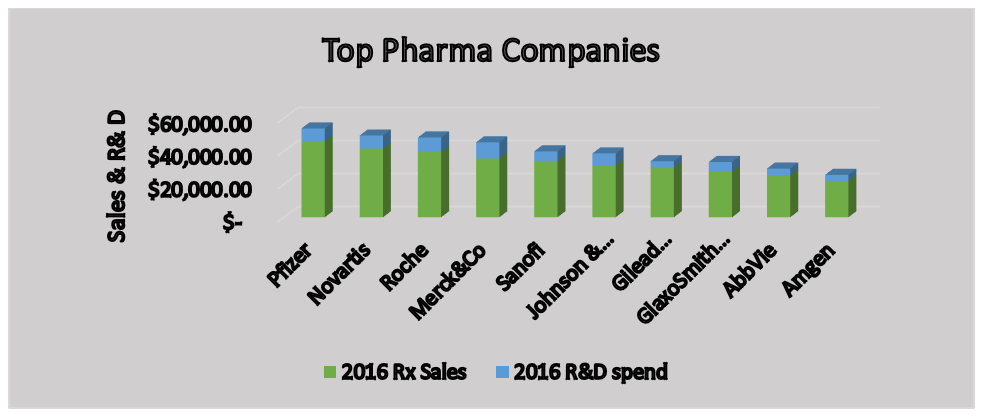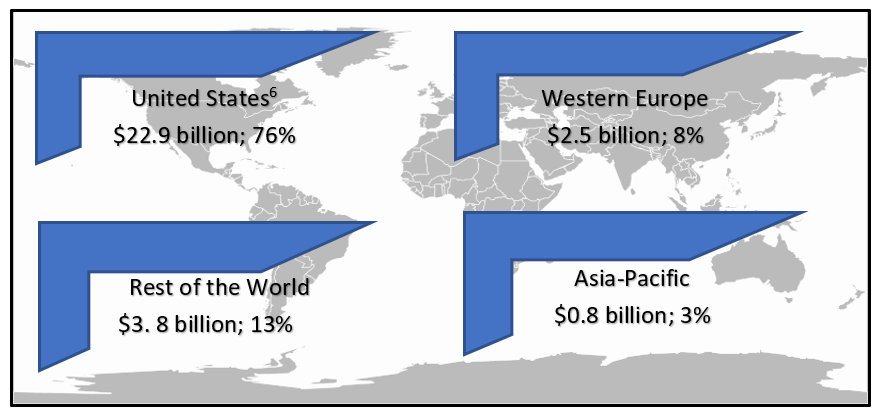The pharmaceutical industry plays a significant role in developing medications and vaccines to reduce the incidence of diseases, to treat diseases and enhance the quality of life of people. The industry�s main contribution is engaging in technological advancements through innovative research to meet the complex healthcare demands of populations. The global market for pharmaceuticals is expected to grow at an annual rate of 4.9% to $1.3 trillion by 2020.[1] The U.S pharma market is expected to grow to $320 billion by 2020. The Japan market, the third largest pharmaceutical market, has a forecasted growth of 3% while the U.S has an expected growth rate of 5.6%.[2]
Key Players in the Industry
Pharma companies experienced modest revenue gains in the past year with rising prices, main patent losses for some pharma companies as well as a decline in M&A activity. Merck & Co is currently ranked No.1 in R&D, although it is fourth in sales. Pfizer remains the top industry prescription sales leader.[3]Revenues and R&D of Top Pharma Companies[4]

Key Factors Driving Demand
The benefits of using oral therapies is influencing pharmaceutical companies to develop new and improved oral therapies to support patients who need accuracy of dose, convenience and ease of compliance to medication regimen. The demand is also due to increases in the incidence of chronic diseases and technological advancements. Novel technologies are being developed to deliver drugs via an oral route. Freedonia�s recent study showed that drug delivery products in the U.S is projected to reach $251 billion by 2019.[5] Emerging markets in the industry include Asia and Latin America. Pharmaceutical sales are forecasted to increase at double digital rates by these new markets.[6]
Key Trends in the Industry
Several major trends are reshaping the pharmaceutical industry and may cause challenges for pharma companies
- Healthcare budgets are experiencing greater pressure due to the rising incidence of chronic diseases
- Increase in demand for medicines in emerging economies compared to industrialized economies
- Innovative medicines are influencing regulators to become more cautious about approving new medicines.[7]
- Drug-pricing concerns will worsen
There have been concerns about drug overcharging for generic drugs and this is influencing international markets such as Japan and Germany to establish tighter price controls on new medicine. Big pharma players such as Eli Lilly, Novo Nordisk and Allergan are committed to voluntary price restraints, while companies such as Novartis and Roche are in favor of value-based pricing. With the trend of price overcharging, pharma companies have to be more transparent with pricing.[8]The fate of many pharmaceutical companies and stakeholders are transforming due to blockbuster drug performances. The evolving treatment regimens are influencing a trend for innovative processes and technological advancement where major pharmaceutical companies are investing in new target-based therapies.[9] Some of the major players setting trends in new drug regimen include Eli Lilly (U.S.), Johnson & Johnson (U.S.), AstraZeneca (U.S), Roche (Switzerland) and Aimmune Therapeutics (U.S.). Current market trends indicate that these classes of drugs are potential blockbuster drugs that will be instrumental in treating different chronic illnesses.Trendsetter Drugs in the Pharmaceutical Domain[10]

Risks
The pharmaceutical industry undertakes several risky ventures that are a growing concern for pharmaceutical companies.� Due to technological advances, pharma companies take risks to have a competitive edge. Some of the risk exposure can affect the advancement of pharma companies. Patient advocacy groups are creating challenges for pharma companies. For example, existence of rare diseases is influencing patient advocacy groups to present the needs of patients with rare diseases to governments and regulators and lobby for changes to enhance inequalities for medical services.[14] Pharma companies must take risks to compete to develop medicine for rare diseases.Tax reform, U.S pricing legislation and the repeal and replace of the Affordable Care Act is posing a risk for M&A activity. Although, opportunistic deals will be evident in the future, pharma companies that have significant amounts of overseas cash will not take risk to overpay on taxes to engage in M&A acquisitions.[15]Between the year 2017 and 2021, it is anticipated that $147 billion of pharmaceutical sales are at risk due to expiring patents.[16] This risk might potentially put a brake on the pharmaceutical industry�s upward trajectory and could indicate a second patent cliff for pharma companies.
Challenges
Pharma companies are facing challenges with developing new medicines and meeting the complex demands of clients. Unprecedented challenges in the pharmaceutical industry are raising concerns about innovations that increase R&D, administrative and sales cost. Some of the challenges include:
- Expiring patents
- Increase in competition by generic companies
- Slower sales growth rates
- Decrease in the number of innovative drugs under development
- Tighter regulatory reviews and standards[17]
These factors are causing pharma companies to change their strategies or growth and sales.Pharma companies may experience more declines in sales, unless patents are renewed.Several issues in the competitive environment are influencing pharma companies to engage in acquisitions of various sizes. Rising customer expectations continue to challenge innovative medicines. Customers are currently seeking new alternative therapies that are clinically and economically feasible.[18]Companies such as AstraZeneca (AZN) and Norvatis are experiencing challenges with growth while its competitors such as Johnson & Johnson, Allergan and Merck & Co. had increased firepower in 2016, giving them a competitive advantage for acquisitions.[19] Pharma companies will have to enhance their growth strategies and use alternative methods to supplement growth. Based on a PwC analysis, pharmaceutical industries are struggling with sales.PwC Analysis on Pharma Industry[20]

One of the challenges that pharma companies are facing is developing a smart multi-channel strategy to use the appropriate medium to deliver promotions and the right information to customers. Pharma companies that had negative publicity in the past must fix their reputational damage. Dubious promotional practices, exploitation of market monopolies and drug pricing in developing countries has affected their public trust and must be mended.[21]Overregulation is an issue that pharma companies are constantly facing. It is perceived as a threat with pricing pressures and possible changes in the U.S pharmaceutical market.[22]
M&A Transactions
M&A activity has been influenced by healthy valuations and a favorable market. Pharma companies are looking to acquire new technology, intellectual property and new drugs. Although, new drugs are entering the pharma market, profitability remains low. [23] Johnson & Johnson had the lead pharmaceutical deals globally in Q1 2017 amongst other pharma companies.[24] Johnson & Johnson�s acquisition of Actelion, a $30 billion deal, increased the value of transactions for pharmaceutical companies.

The first half of 2017 showed the lowest number of transactions in deals and value since 2013. The Q2 2017 deal count of 22 is below the five-year average of 57 deals. [25] One-third of Q1 2017 pharmaceutical transactions were in the biotech sector to support pharma companies to replenish pipelines. Risk sharing via contingency payments fostered Q1 2017 deals. M&A values have experienced a decline by over 60% since Q2 2017 compared to Q3 2017. Deal value declined by $6.0 billion. For example, Merck�s $8 billion joint venture with AstraZeneca did not result in an acquisition. [26]Although deals declined from 2016, deal values such as the acquisition of Actelion Pharmaceuticals in Q1 2017 as well as C. R. Bard in Q2 2017 helped increase the value of deals.[27] Takeda Pharmaceutical Company acquired ARIAD Pharmaceuticals Inc for $5.2 billion to expand its oncology business. Two oncology drugs, Iclusig and Brigatinib, will enhance Takeda�s position in hematology. China�s Sanpower Group Co., Ltd. acquired Dendreon Pharmaceuticals Inc for $0.8 billion, and Sumitomo Dainippon Pharma Co., Ltd. acquired Tolero Pharmaceuticals Inc. for $0.8 billion to assist Sumitomo to refresh its pipeline.[28]In Q4 2017, a few M&A transactions have occurred in the pharma deal market. OncoResponse, a company that focuses on antibody cancer drugs, acquired Paganini Biopharma, a biotech startup. Financial terms for the deal have not been disclosed. Paganini will complement OncoResponse, since OncoResponse has a strong focus on antibody cancer drugs and Paganini recently developed ONCR-201, a monoclonal antibody used in treating ovarian cancer.[29]Mallinckrodt PLC is expected to purchase Ocera Therapeutics Inc. in addition to its mid-stage hepatic encephalopathy, for about $42 million and to close in the fourth quarter of 2017. If the deal is successful, adjusted earnings per share for Mallinckrodt will increase to 35 cents from 25 cents.[30]Deal Activity: Q4 2016 � Q3 2017

The U.S has retained its position in leading transactions and accounted for eight of the ten largest deals during the third quarter.[31] Despite the challenges with the past few quarters, the outlook for M&A transactions in 2018 looks robust.Deal Values for Q3 2017[32]

Opportunities
The pharmaceutical industry looks forward to several opportunities in the future. More than 220 drugs are expected to be introduced in the pharma market by 2021. Most of the drug manufacturing will be outsourced. Pharma companies have opportunities to develop new businesses and increase market share by outsourcing manufacturers. As pharma companies lose sales due to increase in generic drugs, the companies can create portfolios of generic pharmaceutical ingredients (APIs) and present the generic APIs to customers. Outsourcing is expected to increase and provide pharma companies with $105.0 billion in 2021. [33]A survey showed that pharma CEOs choose innovation as an area to capitalize on for opportunities in the future. Pharma companies are more driven to be innovative than most sectors. Human capital is a second area of opportunity that pharma companies will like to focus on.[34]The strong growth in the China pharma market will increase opportunities for U.S based pharma companies to invest and increase their market share. Although, the China pharmaceutical market is valued at $155 billion, a value half of that of the U.S market, the expected growth rate of 10% makes it attractive to invest in the market. The Indian pharma market, valued at $27 billion, is expected to grow by 1.5 times by 2020. The Indian pharma market will create opportunities for pharma companies to develop diabetic drugs since India is expected to have 100 million diabetic patients by the year 2030.[35]The pharmaceutical industry is also benefiting from the aging U.S population. The industry has experienced a season of aggressive growth in the last five years and continues to invest in R&D. Pharma companies are also conducting research and participating in clinical trials to develop new products that can meet the healthcare needs of their clients.[36][1] Trade.gov, 2016 Top Markets Report Pharmaceuticals, INTERNATIONAL TRADE ADMINISTRATION, (2016), https://www.trade.gov/topmarkets/pdf/Pharmaceuticals_Executive_Summary.pdf.[2] Ravikiran, The Strong Growth of Pharma Markets in China, India, and Brazil, BLOG.MARKETRESEARCH.COM, (Sept 5, 2017), http://blog.marketresearch.com/the-strong-growth-of-pharma-markets-in-china-india-and-brazil.[3] Michael Christel. Pharm Exec�s Top Companies 2017, PHARMEXEC.COM, (June 28, 2017), http://www.pharmexec.com/pharm-execs-top-50-companies-2017.[4] Top Pharma Companies based on revenue and R&D. PHARMEXEC.COM.[5] Corinne Gangloff, The Growing Demand for Drug Delivery Products, BLOG.MARKETRESEARCH, (2016), http://blog.marketresearch.com/the-growing-demand-for-drug-delivery-products.[6] Trade.gov, supra note 1.[7] PwC, About the Pharma 2020 Series, PWC.COM, (2017), https://www.pwc.com/gx/en/industries/pharmaceuticals-life-sciences/publications/pharma-2020.html.[8] Andre Moa, 7 Pharma Trends for 2017 that Will Define the industry, TRIBECAKNOWLEDGE.COM, (Jan 12, 2017), http://www.tribecaknowledge.com/blog/7-pharma-trends-for-2017[9] DelveInsight, 5 Potential Blockbuster Drugs to Watch in 2017-2018, BLOG.MARKETRESEARCH.COM, (2017). http://blog.marketresearch.com/5-potential-blockbuster-drugs-to-watch-in-2017-2018.[10] DelveInsight, supra note 9.[11] Potential to be in the best class category of cancer drugs.[12] Landmark treatment regimen, and competition to Shire and Novo Nordisk.[13] Analysis did not provide estimated sales in 2022 for the AR101 drug. BLOG.MARKETRESEARCH.COM.[14] BMI Research, 10 Underappreciated Risks Facing Pharmaceutical companies, BMIRESEARCH.COM, (Mar 11, 2016), https://www.bmiresearch.com/articles/10-underappreciated-risks-facing-pharmaceutical-companies.[15] Christel, supra note 3.[16] Results Healthcare, Pharma & Biotech 2017 Review of outsourced manufacturing, RESULTSHEALTHCARE.COM. (2017), http://resultshealthcare.com/wp-content/uploads/2017/01/Results-Healthcare_Pharma-Biotech-2017-Review-of-outsourced-manufacturing_Whitepaper.pdf.[17] Based on a case study analysis from Top Markets Report.[18] PwC, supra note 7.[19] EYGM Limited, EY M&A Outlook and Firepower Report 2017. Will Payer Leverage and Post-Election Optimism Shift Dealmaking into a Higher Gear?� ERNST & YOUNG GLOBAL LIMITED, (2016), https://www.strategyand.pwc.com/trend/2017-life-sciences-trends.[20] PwC analysis on pharma industry challenges with sales growth and product sales. PwC.com[21] Moa, supra note 8.[22] PwC, 20th CEO Survey, PWC.COM, (2017), https://www.pwc.com/gx/en/ceo-agenda/ceosurvey/2017/gx/industries/pharmaceuticals-and-life-sciences.html.[23] Baker Tilly, Life sciences industry overview and indicators, BAKERTILLY.COM, (Aug 23, 2017), http://bakertilly.com/insights/life-sciences-ma-update-h1-2017/.[24] Statista, Top 10 yet-to-close pharmaceutical deals worldwide based on value announced in the first quarter of 2017 (in billion U.S. dollars), STATISTA.COM, (2017), https://www.statista.com/statistics/398287/top-yet-to-close-pharmaceutical-deals-by-value-globally/.[25] Jonathan Gardner, 2017 Pharma and Biotech Half-Year Review, EVALUATE, (2017), http://info.evaluategroup.com/rs/607-YGS-364/images/EPV_PHHY_2017.pdf.[26]Vir Lakshman, Deal Capsule - Transactions in Pharmaceuticals April 2017, KPMG, (May 30, 2017), https://home.kpmg.com/xx/en/home/insights/2017/05/deal-capsule-transactions-pharmaceuticals-april-2017.html.[27] PwC, Global Pharma & Life Sciences Deals Insights Q32017, PWC.COM, (2017), https://www.pwc.com/us/en/health-industries/publications/pdf/pwc-pharma-life-sciences-deals-insights-q3-2017.pdf[28] Lakshman, supra note 26.[29] Angela Shah, OncoResponse Buys Paganini Biopharma to Add Cancer Drug to Pipeline, XCONOMY, (November 8, 2017), https://www.xconomy.com/texas/2017/11/08/oncoresponse-buys-paganini-biopharma-to-add-cancer-drug-to-pipeline/.[30] Emma Court, Mallinckrodt will buy biotech Ocera Therapeutics, for about $42 mln, MARKET WATCH, (Nov 2, 2017), https://www.marketwatch.com/story/mallinckrodt-will-buy-biotech-ocera-therapeutics-for-about-42-mln-2017-11-02.[31] PwC, supra note 21[32] Deals by target geography in Q3 2017. PWC.COM[33] Results Healthcare, supra note 16[34] PwC, supra note 22[35] Ravikiran, supra note 2[36] Gardner, supra note 25Jenn Abban contributed to this report.
.png)



.png.png)